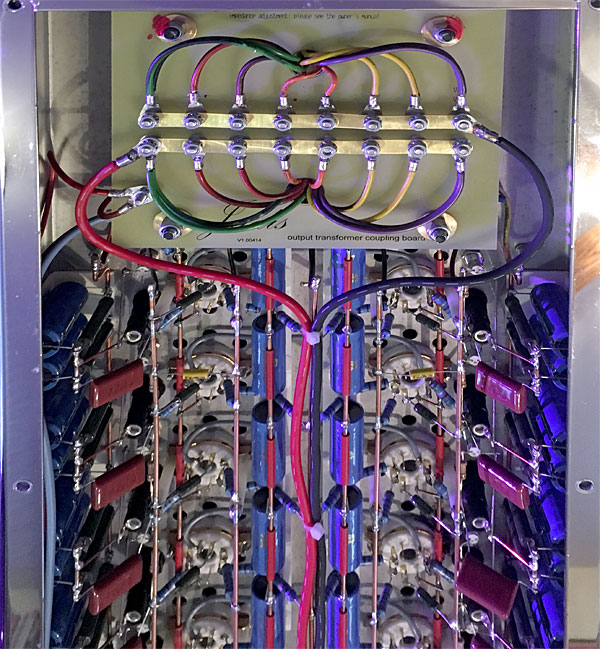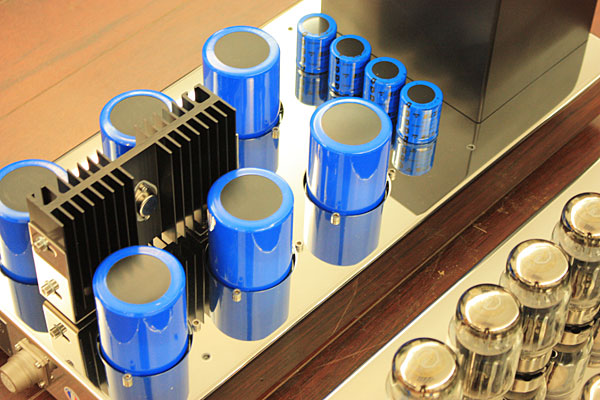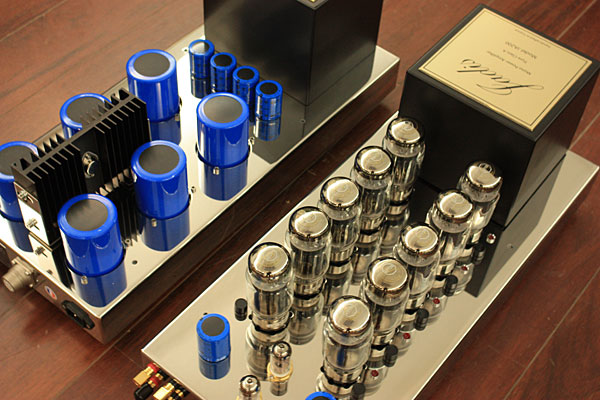| Columns Retired Columns & Blogs |
... Harman-Kardon Citation II amps, run in mono for 120W/ch, instead of these any day.
While the JA200 Mk.IIs put out considerable heat, this was less, I felt, than my reference class-A amps, a pair of Pass Laboratories' solid-state XA200.8 monoblocks.
Listening
When the JA200 Mk.IIs were powered up and all had settled in, everything went smoothly. The Jadis amps were so silent from my listening seat that I felt no need to put an ear to an Alexia tweeter to hear if I could detect any buzz. Nor did I hear any of the low-level background noise I've heard from some tubed gear.
I know that some people prefer to draw lines, consigning equipment and audiophiles to diametrically opposed camps—tubes vs solid-state, analog vs digital, subjective vs objective—as if life were composed of black-and-white polarities rather than infinite shades, a rainbow of possibilities. But as I began my listening, I found I couldn't ascribe the distinct differences I heard between the tubed JA200 Mk.IIs and my solid-state Pass XA200.8s to such clichéd descriptors of tube sound as "bloom," "warmth," or "extra sweetness."

I first listened to the Sinfonia from Handel's opera Alcina, with Christina Pluhar leading the period-instrument ensemble L'Arpeggiata, from their Händel Goes Wild (24-bit/96kHz WAV, Erato 0190295811). The sound was extremely neutral, but with less shine than I'm accustomed to. Highs were less illumined, lows less than fully fleshed out. Neither deep percussion nor high, tinkly instruments had as much edge and ping as I'm used to. Between those two extremes, however, the sound was smooth, supremely well balanced, and captivatingly beautiful.
I checked out the JA200 Mk.II's low-bass extension with two 16/44.1 WAV files that Wilson Audio's Peter McGrath has used to demonstrate how much deep, powerful bass Wilson's Sabrina loudspeaker can produce, and how much space a pair of them can fill. The first, "Laptevinmeri"/"Laptev Sea," from Pan Sonic's Katodivaihe/Cathodephase (Blast First Petite), is pure electronic doo-doo, but it includes very deep sonic-boom effects and fast-snap treble. Through the JA200 Mk.IIs it had a predominant midrange aura that rendered it more attractive than might be deserved by a composition that seems to proclaim, "Look how many sounds I can use to surround an absolutely vacuous concept."
The second file, "Limit to Your Love," from James Blake's eponymous album (16/44.1 WAV, A&M), interrupts Blake's singing with electronic deep-bass effects that, through the Alexias, can take over my music room, seeming to emanate from everywhere at once. Through the JA200 Mk.IIs those blasts were less stunning, and the overall sound was more laid-back than I'm used to. Because the top was a bit toned down, the bass less full, and the soundstage less transparent than though the Pass Labs amps, the midrange now stood out as the sound's main strength.
The performance of Terry Riley's In C on Four Four Three: The Music of Terry Riley, with the Ragazze Quartet and Slagwerk den Haag, a percussion quartet (DSD128, Channel Classics 37816/NativeDSD), is the most colorful, sensationally alive, and mesmerizing recording of this minimalist masterpiece I've heard, with a thrilling climax. With the Jadis amplifiers, timbres were extremely natural and neutral, but everything was a bit mellowed out, the sparkle decidedly toned down. As the piece progressed, it felt as if the JA200 Mk.IIs dove into the middle of every sound, at the expense of undertones and overtones. And despite the amps' fast response, percussive impact was less than ideal.

Nonetheless, the Jadis amps had no trouble conveying complex and contrasting timbres and lines with absolute clarity. This was especially true at the end of In C, when everything comes together at maximum volume. Indeed, even with full symphonic fare, with everything blaring at once, their control was excellent.
Voices, specifically that of soprano Véronique Gens singing "En Sourdine," from Debussy's first set of Fêtes galantes (16/44.1 FLAC rip from CD, Warner Classics 45360-2), sounded absolutely natural and beautiful. Ditto the piano of her accompanist, Roger Vignoles. However, with very bright voices—I sampled many—the lack of emphasis on the leading edge of the note made for smoother if less viscerally thrilling listening.
The mellow voices of the women of Trio Medi’val in "St. Birgitta Hymn: Rosa Rorans Bonitatem," from Rímur, their album with trumpeter Arve Henriksen (24/96 WAV, ECM New Series 2520/HDtracks), sounded extremely natural—gorgeous, really. Ditto the trumpet's timbre in this track, though the last iota of spaciousness was absent. The low, midrange-strong rasp of Sarah Vaughan singing the title track of her Send in the Clowns, with the Count Basie Orchestra (CD, JVC/XRCD 60246), was toned down, and the sound was to die for.
Lou Harrison's astounding Concerto for Violin with Percussion Orchestra, in the recording by soloist Tim Fain, with Angel Gil-Ordóñez conducting the PostClassical Ensemble (24/48 WAV, Naxos 8.559825/HDtracks), also yielded extremely natural timbres—Fain's dark violin, whose tone lacks a strong, silvery edge, sounded wonderful. But while Harrison's crazy assortment of percussion was presented with ideal speed, I wished that instruments with the deepest reach had more impact and tighter focus.

Over the course of three listening sessions devoted to pianist Sarah Cahill's Eighty Trips Around the Sun: Music By and For Terry Riley (24/44.1 FLAC, Irritable Hedgehog IHM 020M), I took in the hi-rez equivalent of four CDs' worth of music performed by Cahill and others. Her piano's sound was extremely natural and transparent through the Jadises, with—no surprise—a caressing softness and toned-down edge. When Cahill performed on a piano that she and composer Samuel Adams had prepared—by placing small resonators and a few dimes on some strings and a small stone to bounce against others, as well as weather stripping and other implements, as well as rubbing the instrument inside and out with superball mallets—the rattling sounded so real that I yelped an immediate "Oh no!" and looked around my music room, trying to figure out what was causing all the noise.
At the end of my listening I revisited my reference Pass Labs XA200.8s to confirm that their percussive slam was indeed more intense, their treble more illumined than the Jadises'. They were. I also verified that, in Iván Fischer and the Budapest Festival Orchestra's recording of Mahler's Symphony 2 (SACD/CD, Channel Classics 23506), the double basses that give extra urgency and dread to the symphony's opening were hardly audible through the JA200 Mk.IIs. While I can't confirm that this bass shyness was due to the Alexias' impedance dip down low, neither Thomas J. Norton's measurements of the Jadis amplifier's predecessor nor Jean-Christophe Calmettes himself suggested that that might be the cause.
Conclusions
For beauty of sound, the Jadis JA200 Mk.II monoblocks have few rivals. They're extremely quiet and fast, and their midrange, neither over-emphasized nor bloated, is to die for. For those who prefer a smooth, mellow sound, the JA200 Mk.IIs demand to be heard and, if means permit, to take up permanent residence. But those who put a premium on brilliant highs and resounding bass may prefer to admire the sounds of the Jadis amps for a hot date or two, without committing to a long-term relationship.

... Harman-Kardon Citation II amps, run in mono for 120W/ch, instead of these any day.

I'm outa touch, I'd thought that the bigger Wilsons all had Servo Woofers. Hmm How do they get away without Woofer control ? Of course a Solid State Amp's dampening is mandatory.
Mr.JVS ends up confirming the Pass excellence, like everyone else.
Tony in Michigan
ps. there is an Engineering document covering Audio Output Tube spacing, I think the minimum gap is far greater than glass to glass ( which looks like a Submarine Missile Launch arrangement )

... is rather tightly packed, but there are perforations in the chassis between the tubes to promote air flow.
https://i1.wp.com/i1190.photobucket.com/albums/z446/sthull/CES13/Part1/CT6A6117.jpg?resize=640%2C427

Egads,
Audio Research looks like ( a ) Schiit !
I'll pass.
It seems a bit outrageous in appearance, like a razor wire tattoo ( around the neck ) kinda thing.
Maybe I'm too Old-School to appreciate the lack of Gage.
The way Woo Audio does exposed glass Tubes in their FireFly is stunningly beautiful, isn't it?
I'm a tube fan, especially in Microphones used for Studio Recordings of Vocals. Tubes in Pre-Amps are one of my favorite things. Tubes in Amps have never performed well for me, with the ( only ) exception being the Conrad-Johnson MV-45a driving MG2 Maggies with Music Hose MIT750.
The Tune Audio Avaton Horn Loudspeaker gets Tube amplification and is flat out addictive. ( leave your financials in the Safe or you'll kill yourself to own it )
Exposed tube are silliness from trendy MeToo's
Tony in Michigan
ps. William Z is turning over in his vault.

No Servo Woofers ? new
Submitted by tonykaz on February 2, 2018 - 1:59pm
"I'm outa touch, I'd thought that the bigger Wilsons all had Servo Woofers. Hmm How do they get away without Woofer control ? Of course a Solid State Amp's dampening is mandatory."
The reviewers Wilson Alexia are full range passive (no active bass) but that bass can go as low as .9ohm EPDR, I can't see any tube amp even this one getting the very best out of the Alexia's bass, like a big current pumping solid state could do.
Then you can read between the lines of the reviewer.
"the bass was also quite good"
"the bass less full"
"the double basses that give extra urgency and dread to the symphony's opening were hardly audible through the JA200 Mk.IIs. While I can't confirm that this bass shyness was due to the Alexias' impedance dip down low"
Cheers George

... a pair of the Parasound JC-1 amps.
>4kW output into a 1Ω load.
https://www.stereophile.com/content/parasound-halo-jc-1-monoblock-power-amplifier-measurements

I had them way, way back in my pre-Stereophile days. Given that I'm reviewing different equipment each month, as well as reviewing recordings and covering audio shows and teaching about opera and art song and covering concerts [see https://classicalvoiceamerica.org/2018/02/03/a-too-emotional-violin-concerto-played-to-the-hilt/ -- I'm really proud of this review] and plays and writing concert previews and..., auditioning extra products is not so easy.
The good news is, the Wilson Audio Alexia 2 loudspeakers, with a nominal impedance of 4 ohms that dips to 2.8 in the bass, demand less of an amplifier. Review and follow-up of those speakers to come.

... of the Wilson Audio Alexia Series 2.
Will also need to see the phase angle test results to determine just how severe a load might be presented by that speaker.
Parasound versus Pass Labs makes a fascinating comparison. Both John Curl and Nelson Pass have identified certain (and different) aspects of the amplifier distortion spectrum which each seeks to optimize in order to achieve a specific sound quality. JA should try to arrange a simultaneous video interview with these two designers.
Regarding driving the Jadis amp from the dCS DAC, no compatibility issue is evident based upon the specifications. The Jadis has an input impedance of >100kΩ and an input sensitivity of 910mV. The dCS can drive a load as low as 600Ω (with 10kΩ-100kΩ being recommended) and can be set for a 2V full-scale maximum output - more than enough to supply the specified 910mV.

Without utilizing an upstream preamp, you have NOT heard what these amps are capable of. IME, this is always the case with tube amps...and most ss amps as well! Your Dcs DAC was a very poor choice to drive these amps! Strapping the amps for a 1 ohm load, more than likely not the best solution either...the 4-8 ohm strapping would have been more appropriate. I would strongly suggest a follow-up review; this time with a decent preamp upstream and different strapping. I suspect ( strongly) that your opinion of the bass response and the treble concerns would be ameliorated.
Commenting/reviewing mismatched components is not really fair to the component manufacturer under consideration. All IMHO.

a. The choice of strapping was made by the manufacturer and dealer. You may wish to correspond with them. They had the opportunity to request a follow-up review in Manufacturer's Comments, and did not do so.
b. Why is the dCS gear a poor choice to drive these amps and other amps? I have certainly had no problem with any of the SS amps I've reviewed so far. Why are the products mismatched?
FYI, for my next two reviews where a preamp is definitely required, I have been sent a loaner two-piece Lamm preamp. How I'm going to fit it on my rack will be determined shortly.

Ok, you actually brought up a good question...why is the Dcs a poor choice to drive these amps...and not ss amps? I believe it is a poor choice for ALL amps. The Dcs is designed as a DAC...not as a preamp. ( BTW, the ONLY DAC that might qualify SQ wise to drive an amp is the new MSB Select DAC; and as you may know, the Dcs is not in that league at all) A great preamp will have the DRIVE to handle a tube amp...like the Jadis 200Mk2's. The Lamm's you are going to be receiving would certainly qualify in this way. Pair the Lamm's and the Jadis and you would have a much better idea as to what the Jadis can bring to the table. Why are the products mismatched...YOU SHOULD NOT HAVE TO ASK THIS QUESTION!! Pairing a very difficult to drive speaker ( ala WILSON ALEXIA's-- which have a brutal drop in their impedance in the bass) with a tube amp is asking for trouble, IME. You heard what the combo brought about..along with the mismatch of the DAC!! Wake up man...it's horses for courses in our hobby. Would you pair an Apogee Scintilla with a 3 watt flea powered SE amp??? You would IF you do not believe in such a thing as "mismatching'!! --and were inexperienced in the hobby.
BTW, the dealer you mention ( who shall remain unnamed) sold a friend of mine some lower powered Jadis amps for his difficult to drive Gamut speakers( which the very same dealer also sold -- and we are NOT talking about cheap speakers here) Knowing full well the size of my friend's room...Do you think this very same dealer is going to get any of my friend's future business??
If, as you say, the manufacturer has not requested a follow-up, they are making a serious mistake. However, considering they are out of country, that may be a reason. Although, i cannot comprehend why their rep in the US is not all over this!!

I have no answers for absolute statements such as "the ONLY DAC that might qualify SQ wise to drive an amp is the new MSB Select DAC; and as you may know, the Dcs is not in that league at all," and "If, as you say, the manufacturer has not requested a follow-up, they are making a serious mistake."
Have you considered a job as an audio consultant?

I’m not considering a job as an audio consultant, but I may have to consider the job opening for an audio reviewer. LOL.
BTW, have you actually heard the new MSB Select DAC...doesn’t sound like it, otherwise you would understand why the difference can be stated as an absolute.

Submitted by Jason Victor Serinus on February 6, 2018 - 4:29am
"Wilson Audio Alexia 2 loudspeakers, with a nominal impedance of 4 ohms that dips to 2.8 in the bass, demand less of an amplifier."
You had your doubts with this statement also Victor.
""the double basses that give extra urgency and dread to the symphony's opening were hardly audible through the JA200 Mk.IIs. While I can't confirm that this bass shyness was due to the Alexias' impedance dip down low"
Once we've seen the impedance in conjunction with the -phase angle graph in the test, only then we'll see the true EPDR (equivalent peak dissipation resistance) impedance in the bass as seen by the amp, and I will lay money on it, that's it's going to be lower than 2.8ohm
Cheers George

i had a pr of ja80s and later a da60 integrated, both sounded fine but the da60 was one of the most unreliable pieces of gear i ever owned.
hopefully the latest jadis are built to go the distance.

George, I would be willing to bet that your supposition that the Alexia’s drop below 2.8 ohms is going to be spot on!
IMO, utilizing the new Jadis 200 Mk2’s with this particular set-up was a recipe for failure from the beginning....too bad that a good amp is not getting the precise and accurate review that it deserves. Perhaps request a follow up with more appropriate ancillary gear...and another reviewer, lol.